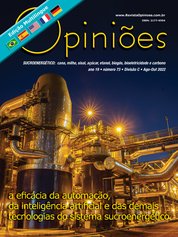Marcelo Pierossi
Diretor da Lidera Consultoria e Projetos
OpAA73
A utilização eficiente dos dados na gestão de operações mecanizadas
O uso crescente de dispositivos conectados aos equipamentos agrícolas e sistemas computacionais tem nos trazido a possibilidade de gestão em tempo real das mais diversas operações agrícolas, como agricultura de precisão, irrigação, mecanização, abastecimento de combustível, meteorologia, entre outras aplicações, hoje comuns. Uma das aplicações mais bem-sucedidas dentre as citadas acima é a gestão das operações mecanizadas agrícolas através da telemetria.
O custo das operações agrícolas tem se elevado consideravelmente nos últimos tempos devido ao aumento do valor do combustível e também do custo de aquisição das máquinas agrícolas, portanto a gestão da frota de máquinas é cada vez mais importante no planejamento, execução e controle das operações agrícolas, por envolver diretamente a rentabilidade da produção agrícola.
Os sistemas de telemetria coletam, por meio de sensores, informações referentes ao desempenho das máquinas, como rotação e temperatura do motor; consumo de combustível e localização do equipamento, permitindo que diversas variáveis de desempenho sejam calculadas de forma automática, como tempo ocioso, pontos de parada, eficiência durante a operação, área trabalhada, entre outras.
Entretanto, existem algumas dificuldades relativas à conectividade desses sistemas devido à baixa cobertura de rede celular, obstáculo que vem sendo superado por alguns fornecedores através de utilização do investimento em redes locais privadas (3G, 4G, LoraWan, Zigbee etc.).
Dessa forma, todo projeto de telemetria das operações deve contemplar um estudo aprofundado dos objetivos que a organização pretende ao realizar investimento de tal monta. Na introdução dos sistemas de gestão das operações, devemos iniciar com um estudo detalhado dos processos agrícolas e das variáveis envolvidas em cada um dos processos, de forma a possibilitar a criação de métricas de análises e indicadores de relevância. Essas métricas e indicadores-chave de desempenho devem ser monitorados de forma contínua pela equipe do controle de operações e possibilitam detectar rapidamente, no caso de um monitoramento eficiente, desvios em alguns processos, melhorando a qualidade e reduzindo custos operacionais.
Segundo o Dicionário Oxford, indicador-chave de desempenho (KPI em inglês) é uma medida quantificável usada para avaliar o sucesso de uma organização, funcionário, etc. no cumprimento dos objetivos de desempenho. Os indicadores-chave de desempenho são importantes métricas que quantificam o desempenho da empresa, com base em seus objetivos organizacionais, comparando os resultados obtidos com os planejados.
Devem estar inseridos em sistemas automatizados que possibilitem captar e compartilhar as informações de forma ágil, acompanhando os resultados em tempo real, e tomar decisões com mais segurança, realizando os ajustes necessários, desenvolvendo oportunidades e medindo seu progresso que reflete um determinado período. Dessa forma, a definição adequada do período de apuração é de fundamental importância.
A definição dos indicadores-chave deve seguir critérios bem-definidos para que sejam representativos e em quantidade adequada à gestão eficiente, por isso as seguintes questões devem ser levadas em conta durante a escolha dos indicadores:
O que precisamos realmente medir?
O que será mensurado?
Quais dados estão disponíveis para a equipe?
Qual o intervalo entre as medidas?
Qual a frequência que devemos informar aos gestores?
O que é considerado sucesso?
Como identificar se o desempenho está tendendo para longe dos objetivos?
Quais dados os envolvidos estariam mais interessados?
Os conceitos gerais de indicadores de desempenho contemplam o Índice, que é o número que representa o desempenho obtido em um processo pelos indicadores de desempenho, o objetivo, que são os valores a serem visados em um período predeterminado, usando os indicadores de desempenho e o limite de tolerância aceitável para a variação de valores, fora da qual indicam que a conduta do processo é crítica. Com isso, algumas ações devem ser tomadas.
Definidos os indicadores-chave, a próxima etapa é fazer com que a equipe que realiza o monitoramento e controle extraia conhecimento a partir da transformação dos dados, ou seja, coletar um conjunto de informações (dados), torná-los públicos através de alguma forma de comunicação (informação) e, então, compreender o fato para tomada da decisão (conhecimento).
A correta utilização dos dados coletados em abundância em tempo real pelo campo nos traz a possibilidade de se fazer a análise preditiva das operações. As análises preditivas consistem no uso de tecnologias para antecipar comportamentos futuros ou estimar resultados desconhecidos, com base em dados atuais e históricos, baseados em modelos estatísticos, machine learning, mineração de dados e inteligência artificial.
Com base nessas análises, deixamos de tomar decisões baseadas unicamente na intuição, conseguindo estabelecer um prognóstico mais sólido para cada ação, considerando uma maior quantidade de dados de diferentes fontes, criando diferentes cenários e avaliações. Uma das primeiras aplicações é relativa ao padrão de falhas em máquinas e equipamentos, possibilitando uma atuação prévia no equipamento, reduzindo tempos perdidos e custos nas manutenções.
Apesar dos benefícios já possíveis para os sistemas de telemetria disponíveis no mercado, existem algumas barreiras a serem superadas. A primeira delas é com relação à contratação de mão de obra, peça fundamental na utilização adequada dos recursos computacionais instalados. A falta de integração dos diferentes sistemas é outro problema a ser resolvido, visto que as informações se encontram dispersas em vários locais, dificultando a correta visualização de como elas interagem na operação.
Entretanto, o pontapé inicial desse novo mundo, o mundo analítico, na gestão das operações agrícolas já foi dado, e existem empresas colhendo bons resultados de projetos bem estruturados, com pessoal qualificado e dedicado e ferramentas adequadas, gerenciando o aumento da eficiência e da sustentabilidade da operação e de forma a reduzir os custos operacionais e o consumo de combustíveis fósseis.




